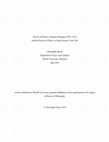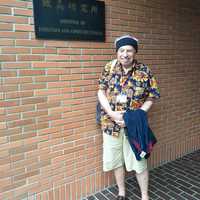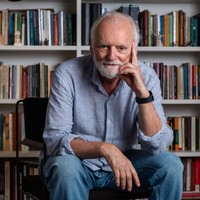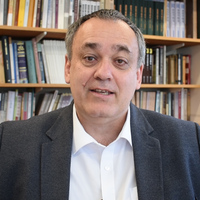Articles by Christopher Byrne
Philosophy East and West, 2020
This essay addresses why poetry is a privileged means of expressing Zen Buddhist dialectics by an... more This essay addresses why poetry is a privileged means of expressing Zen Buddhist dialectics by analyzing Hongzhi Zhengjue’s (1091-1157) verses on the “Five Ranks.” Hongzhi’s poetry synthesizes ultimate and conventional truths in a performative manner by crafting multiple layers of non-dual meaning within conventional, dualistic language.

International Journal of Buddhist Thought and Culture, 2019
Zen master Hongzhi Zhengjue (1091-1157) is best known for bringing the Caodong lineage to promine... more Zen master Hongzhi Zhengjue (1091-1157) is best known for bringing the Caodong lineage to prominence during the Song dynasty and for coining the phrase “silent illumination” (mozhao) which came to define Caodong meditative practice. Hongzhi was anything but silent, however, in his promotion of the insights of wordless meditation and produced one of the most extensive recorded sayings (yulu) in the Song, whose poetic content far exceeds any other yulu of the period. In this article, I argue that poetic composition is a central component of Hongzhi’s Zen practice and a privileged means for asserting a distinct Caodong identity. Rather than constituting a rejection of words and letters, the principle of silence transforms the character of Hongzhi’s poetic compositions in a manner that characterizes his Caodong practice. Hongzhi primarily promotes and articulates his vision of silent meditation through poetic means, including his famous “Inscription of Silent Illumination” (Mozhao ming), as well as the images of the “withered tree” and “cold ashes” associated with the Caodong meditative ideal of absolute silence. Furthermore, when these texts and images are analyzed in their poetic contexts, “silent illumination” appears to be far more dynamic than usually conceived, thus, accounting for an active component that encompasses the vital role of words and letters. In this manner, Hongzhi depicts a vision of Caodong practice that synthesizes wordless meditation with poetic composition as two complementary sides of a single mode of religious cultivation. Furthermore, this paradoxical synthesis corresponds to the identification of the ultimate and conventional truths within Caodong Zen philosophy. In sum, contrary to the predominant perception of Caodong practice as simply identified with absolute silence, for Hongzhi, an active and dynamic engagement with poetic composition more accurately characterizes how he imagined the lineage’s teachings.

Journal of Religion and Culture , 2016
This paper examines how the Buddhist laywoman and poet Tao Shan 陶善 (1756-1780) utilized poetic di... more This paper examines how the Buddhist laywoman and poet Tao Shan 陶善 (1756-1780) utilized poetic discourse in order to articulate an indirect critique of gender discrimination prevalent within both the Buddhist tradition and the dominant Neo-Confucian ideology of her time. In many of her poems, Tao Shan embraces her seclusion as a woman within the inner domestic realm. As a writer, her words appear to be confined to the private sphere, and as a devoted Buddhist practitioner, she directly affirms the presumed restrictions on women’s religious potential that are particularly transparent within her Pure Land Buddhist practice. Yet, in a paradoxical fashion typical of Chinese Buddhist thought, Tao Shan subverts and overturns the conventional meaning of the limitations imposed on women’s activities—not by outright rejecting them—but by reinterpreting those limitations according to the esteemed value placed upon silence, reclusion, and humility within the Chinese religious tradition, thereby legitimizing the value of her literary work and her full potential for religious realization.
Brill Encyclopedia of Buddhism, 2015
Translations by Christopher Byrne
The Secular Heretic, 2020
https://thesecularheretic.com/following-hanshan-by-fenyang-shanzhao/
Reviews by Christopher Byrne
https://readingreligion.org/books/flowers-blooming-withered-tree, 2021
Humanities Professor Dawson College Steven Heine's recent monograph is a welcome addition to his ... more Humanities Professor Dawson College Steven Heine's recent monograph is a welcome addition to his already prolific scholarship on Dōgen (1200-1253) and Zen poetry, offering an accessible, engaging, and poetic study that pursues new directions in Dōgen studies. As an impressive body of scholarship now exists on
Journal of Chinese Religions, 2017
Journal of Asian Studies, 2011
Chinese Literature: Essays, Articles, Reviews, 2009
Dissertation by Christopher Byrne

Dissertation, 2015
This dissertation fulfills two aims: First, it provides the first comprehensive analysis of the p... more This dissertation fulfills two aims: First, it provides the first comprehensive analysis of the poetic genres written by Chan Buddhist monks as part of their religious vocation and as collected within yulu (recorded sayings) during the Song dynasty (960-1279). Second, it demonstrates how Chan’s claim to an ineffable insight “not dependent on words and letters” (buli wenzi) paradoxically informs the literary character of its monastic poetry. My research focuses on the poetry of master Hongzhi Zhengjue (1091-1157), who, along with being one of the most prolific poets among Chan masters, is renowned for advocating the meditative practice of “silent illumination” (mozhao) that defines his Caodong sect. I argue that the principle of silence defines the nature of Hongzhi’s poetics as the primary theme and image of his verse.
By organizing my literary analysis of yulu according to genre, I demonstrate how each poetic genre adopts conventions particular to its own literary and religious functions, while engaging with the principle of “beyond words” that characterizes yulu collections as a whole. In Chapter One, I illustrate how poetry has remained an integral and significant component of Chan yulu collections since they began to be published as independent works during the early Song dynasty. I then argue that Hongzhi’s doctrinal verses (Chapter Two) poetically express a philosophical paradigm, in which silent meditation and linguistic expression can be seen as complementary aspects of a single practice. In Chapter Three, I show how songgu—verses written in response to Chan gong’an (J. koan)—formed the literary focal point of Chan gong’an collections and how their composition was a central aspect of monastic training and pedagogy, as also reflected in the poetic character of the dialogical sermons that epitomize yulu. In Chapter Four, I examine how the social-occasional poetry of Chan masters like Hongzhi was collected as, and transformed into, Buddhist gatha (Ch. jisong) during the Song, expressing a non-dualistic doctrinal perspective within poetry (a.) exchanged with monks, nuns, laymen and laywomen, (b.) written in the reclusive mode, and (c.) composed for the ritual and economic activities of the monastery. Finally, in Chapter Five, I analyze a sample of the hundreds of portrait encomia (zhenzan) Hongzhi inscribed on his own portrait as a means of promoting the master as an embodiment of total silence in which the distinction between language and silence itself is ultimately dissolved. I conclude that Hongzhi’s poetry represents a distinctively Chan poetics crafted to merge the non-discriminative wisdom of silence with literary expression.










Uploads
Articles by Christopher Byrne
Translations by Christopher Byrne
Reviews by Christopher Byrne
Dissertation by Christopher Byrne
By organizing my literary analysis of yulu according to genre, I demonstrate how each poetic genre adopts conventions particular to its own literary and religious functions, while engaging with the principle of “beyond words” that characterizes yulu collections as a whole. In Chapter One, I illustrate how poetry has remained an integral and significant component of Chan yulu collections since they began to be published as independent works during the early Song dynasty. I then argue that Hongzhi’s doctrinal verses (Chapter Two) poetically express a philosophical paradigm, in which silent meditation and linguistic expression can be seen as complementary aspects of a single practice. In Chapter Three, I show how songgu—verses written in response to Chan gong’an (J. koan)—formed the literary focal point of Chan gong’an collections and how their composition was a central aspect of monastic training and pedagogy, as also reflected in the poetic character of the dialogical sermons that epitomize yulu. In Chapter Four, I examine how the social-occasional poetry of Chan masters like Hongzhi was collected as, and transformed into, Buddhist gatha (Ch. jisong) during the Song, expressing a non-dualistic doctrinal perspective within poetry (a.) exchanged with monks, nuns, laymen and laywomen, (b.) written in the reclusive mode, and (c.) composed for the ritual and economic activities of the monastery. Finally, in Chapter Five, I analyze a sample of the hundreds of portrait encomia (zhenzan) Hongzhi inscribed on his own portrait as a means of promoting the master as an embodiment of total silence in which the distinction between language and silence itself is ultimately dissolved. I conclude that Hongzhi’s poetry represents a distinctively Chan poetics crafted to merge the non-discriminative wisdom of silence with literary expression.
By organizing my literary analysis of yulu according to genre, I demonstrate how each poetic genre adopts conventions particular to its own literary and religious functions, while engaging with the principle of “beyond words” that characterizes yulu collections as a whole. In Chapter One, I illustrate how poetry has remained an integral and significant component of Chan yulu collections since they began to be published as independent works during the early Song dynasty. I then argue that Hongzhi’s doctrinal verses (Chapter Two) poetically express a philosophical paradigm, in which silent meditation and linguistic expression can be seen as complementary aspects of a single practice. In Chapter Three, I show how songgu—verses written in response to Chan gong’an (J. koan)—formed the literary focal point of Chan gong’an collections and how their composition was a central aspect of monastic training and pedagogy, as also reflected in the poetic character of the dialogical sermons that epitomize yulu. In Chapter Four, I examine how the social-occasional poetry of Chan masters like Hongzhi was collected as, and transformed into, Buddhist gatha (Ch. jisong) during the Song, expressing a non-dualistic doctrinal perspective within poetry (a.) exchanged with monks, nuns, laymen and laywomen, (b.) written in the reclusive mode, and (c.) composed for the ritual and economic activities of the monastery. Finally, in Chapter Five, I analyze a sample of the hundreds of portrait encomia (zhenzan) Hongzhi inscribed on his own portrait as a means of promoting the master as an embodiment of total silence in which the distinction between language and silence itself is ultimately dissolved. I conclude that Hongzhi’s poetry represents a distinctively Chan poetics crafted to merge the non-discriminative wisdom of silence with literary expression.